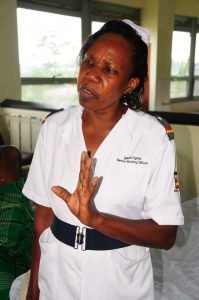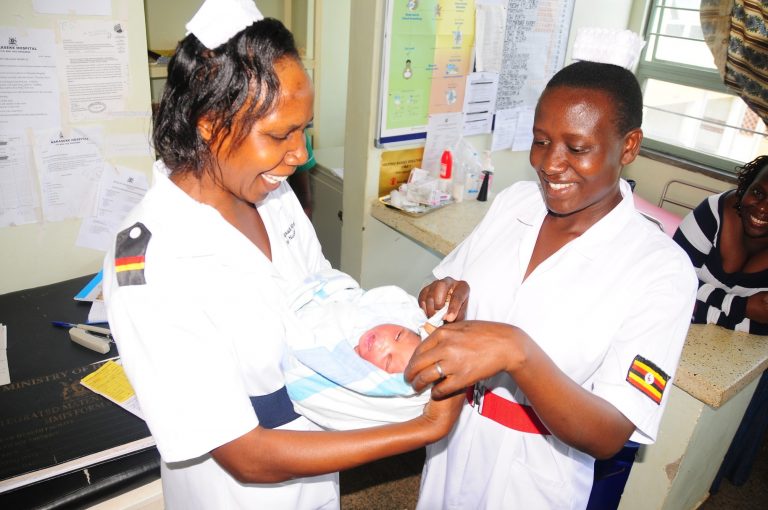This story on quality midwifery care is taken from Childbirth in Uganda: Stories from women and health workers – a booklet of 10 stories about the birth experience from the perspectives of mothers and healthcare workers – mostly midwives. Agnes Ijakait’s story is featured in this blog.
“The work has not been without challenges,” recounts Sister Agnes Ijakait as she reflects on one of her most emotional experiences as a midwife – a day when she dealt with the deaths of two mothers. These deaths led to a life-changing lesson – listen to your patients. This is a lesson she teaches all midwives under her supervision and even those outside Nakaseke Hospital.
Sister Ijakait finds midwifery very interesting and says her greatest satisfaction is when a mother comes to hospital to deliver and leaves alive and healthy with a bouncing baby. Sister Ijakait is a senior nursing officer in Nakaseke Hospital, a government hospital located in the Nakaseke district of Uganda; she is also a mother of two. The Nakaseke Hospital serves a catchment area that covers Luweero, Wakiso, Kiboga, Nakaseke, and Kampala district. Ijakait’s career in midwifery, which spans over 28 years, started when she was handpicked for training during the war in the Teso region in the late 1980s. She later upgraded to a registered midwife in 1990 and has since undertaken courses in administration and communication to support her work as a senior midwife and administrator.
She has worked in the Kamuli Mission in the Nsambya and Nakaseke hospitals helping “millions of babies to take their first breath,” as she says, “The most challenging case in my career happened one morning when there were two emergency cases in the labour ward. One mother had APH (ante-partum haemorrhage or bleeding before birth) while another was having PPH (post-partum haemorrhage or bleeding after birth).
“Both were in a dire situation, so doctors and nurses were running around the labour ward preparing the necessary supplies to stop the bleeding. As I hurried back to the labour ward, I was stopped suddenly in my tracks by a mother pulling at my dress with all her strength, trying to capture my attention. I looked down at her and she whispered, ‘Nurse, I am dying’. Something in the woman’s eyes and voice captured my attention. An inner voice told me, ‘You better take a look at this woman’.”
As Ijakait recounts the story, tears well up in her eyes. “I quickly mobilized some nurses to put the woman on a stretcher and wheel her to the labour ward where we discovered that she had a rupture. I said to myself, “All these mothers are going to die … this one, the other one, and the other one…” And indeed, we lost the mother with the rupture and the one with APH.

“Midwifery is about life. That is why you see me crying; I don’t want a mother to die. It is very important for midwives to listen to mothers. If someone says, “I am dying ,” listen and act decisively. Unfortunately I learnt that lesson the hard way. That experience shook the hospital up and jolted us into a heightened sense of alertness on issues of maternal health. We put in place emergency measures to prevent such deaths and trained the midwives in communication and response.”
Blog by Stella Kigozi of Save the Children International, Uganda Office (This blog is part of our midwifery blog series.)
Do you know a midwife who is working to make a difference for the world’s mothers and babies? Help tell her story! Over the coming weeks leading up to the ICM triennial congress we will collect stories about midwives who are leaders in their field and champions for newborns. Send us a 300-600-word blog that include the midwife’s name, country of work, details about their career and how she or he is making a difference in the world for newborns.
Please send all blog submissions to info@healthynewbornnetwork.org. We will post blogs on HNN and our social media accounts with the hashtag #MidwivesVoices and #ICM2017.
